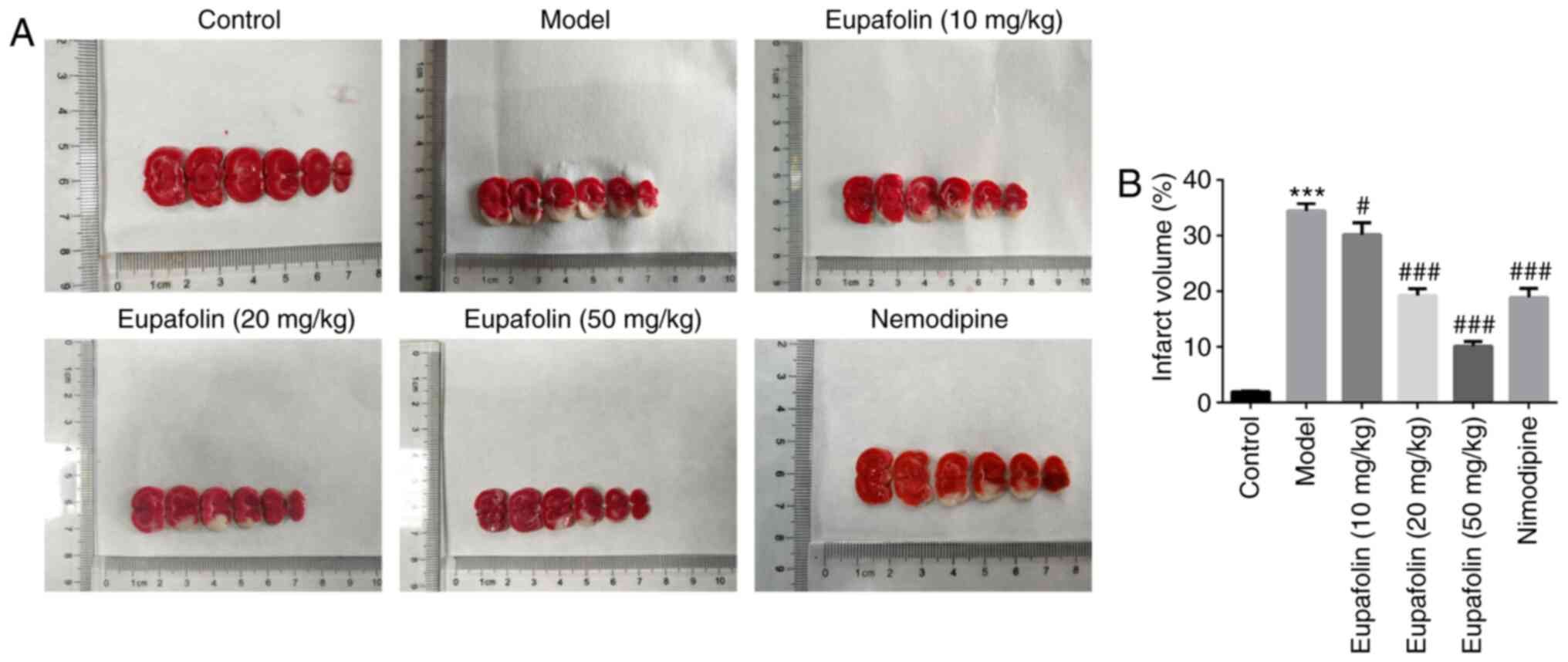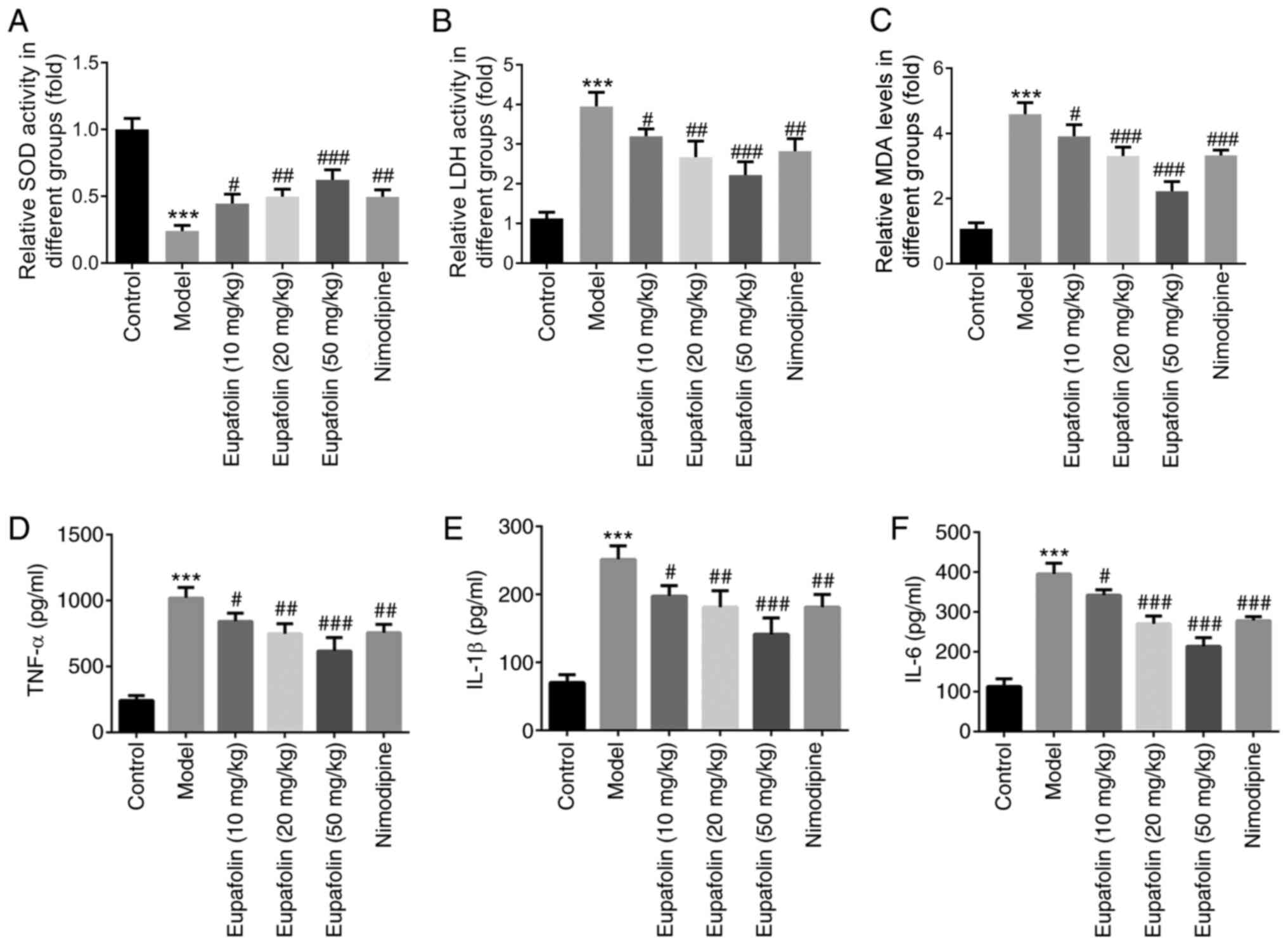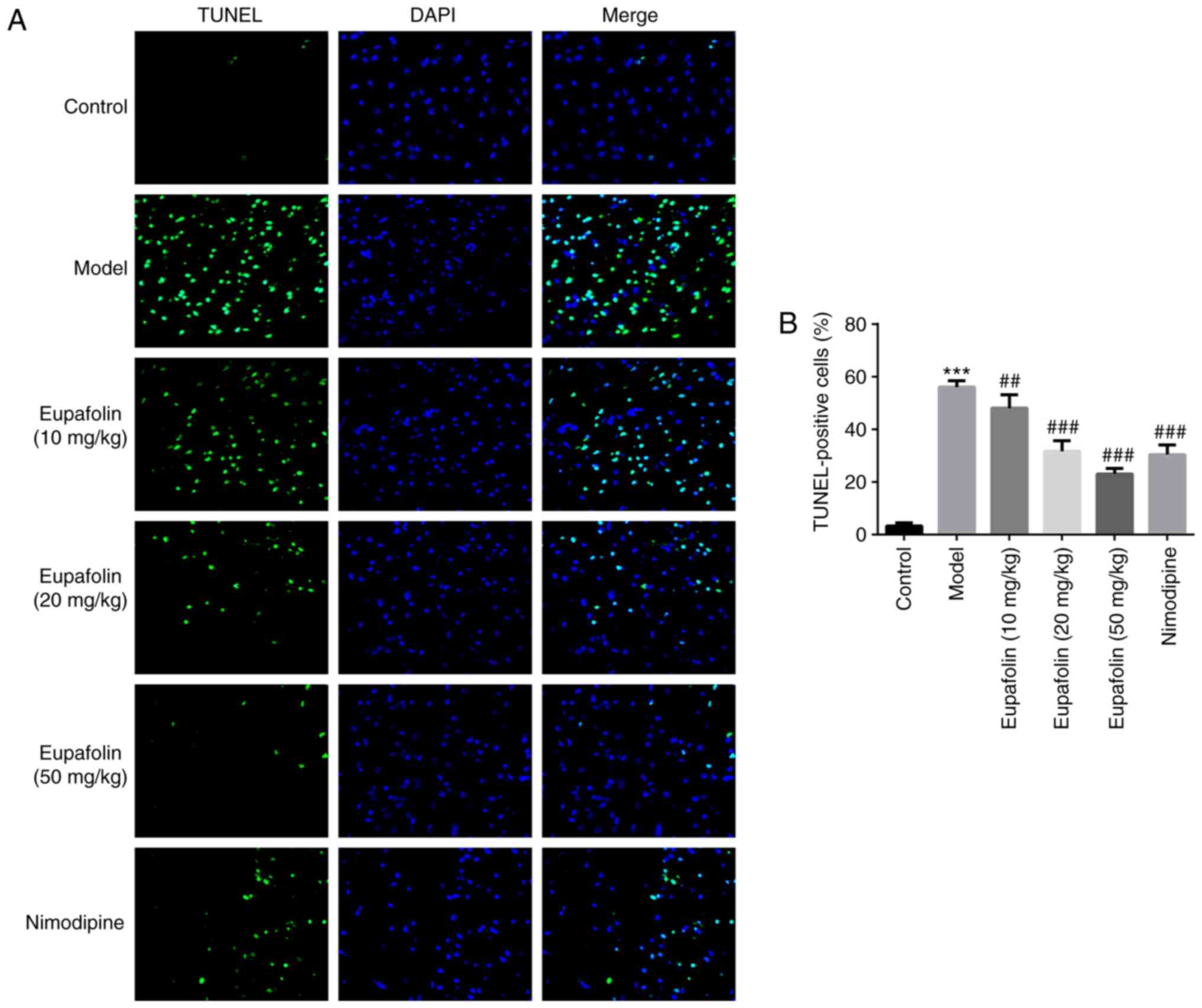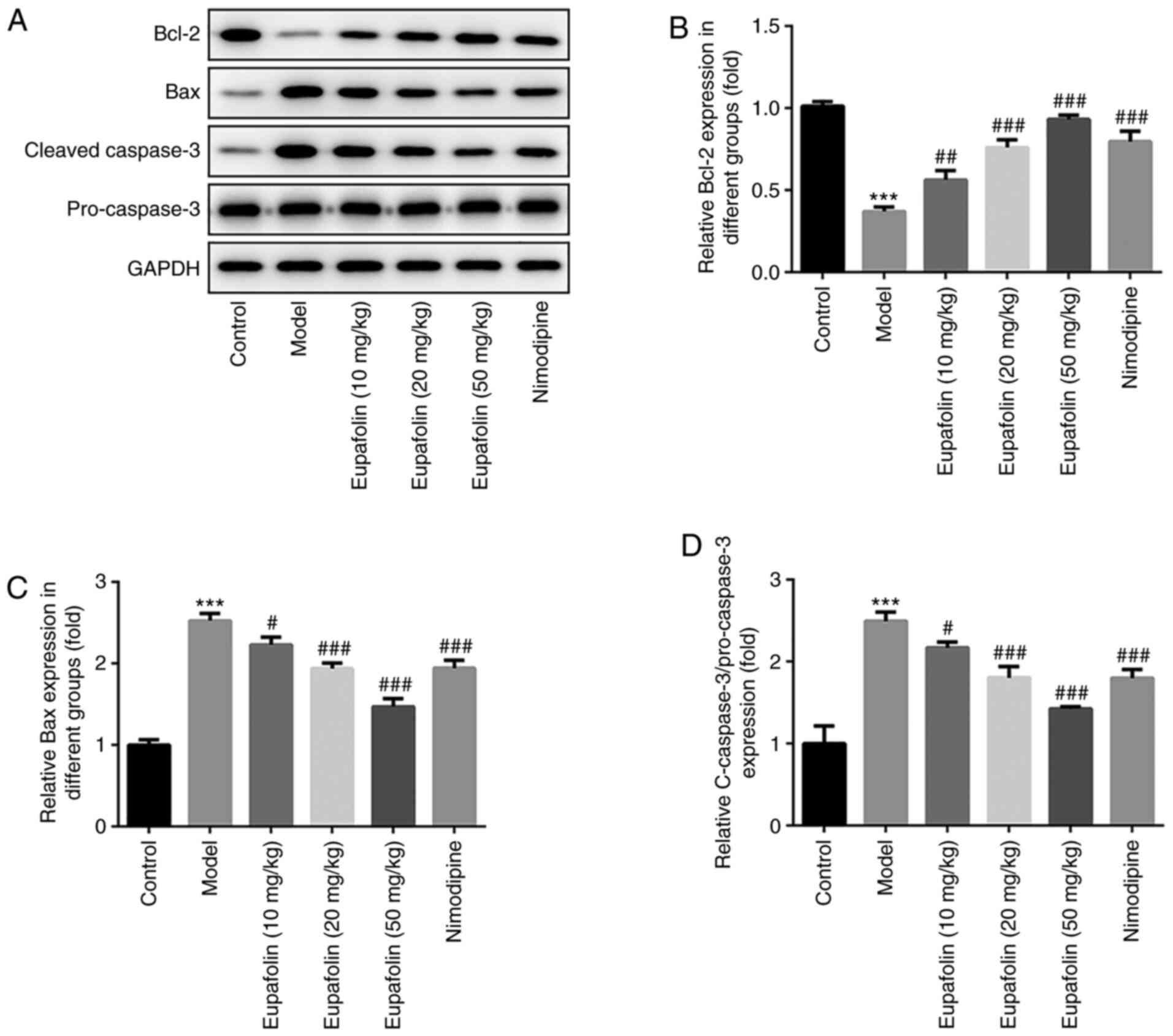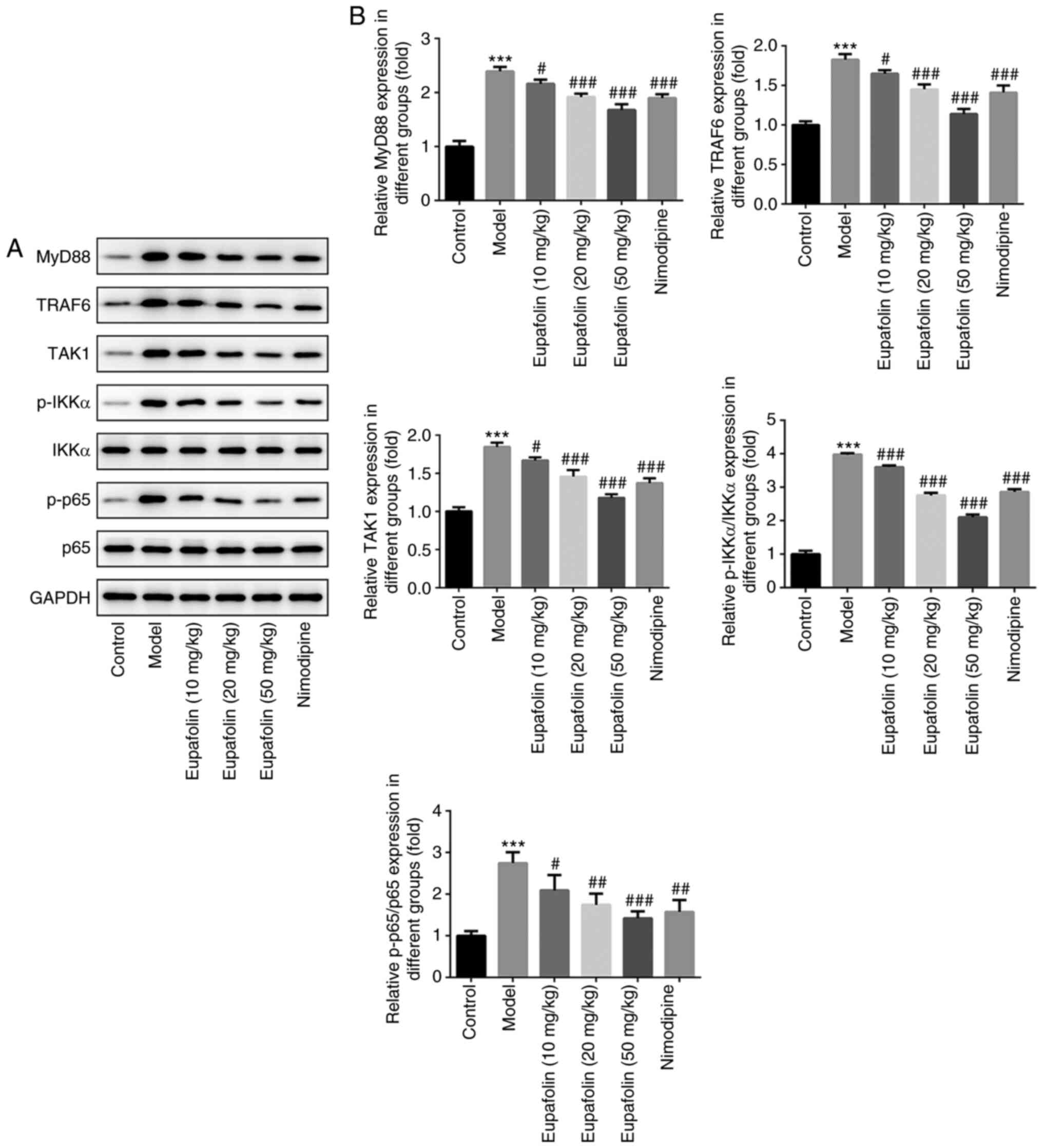|
1
|
Bustamante A and Montaner J: Author
response: Usefulness of ADAMTS13 to predict response to
recanalization therapies in acute ischemic stroke. Neurology.
91:8992018. View Article : Google Scholar : PubMed/NCBI
|
|
2
|
Kahl A, Blanco I, Jackman K, Baskar J,
Mohan HM, Rodney-Sandy R, Zhang S, Iadecola C and Hochrainer K:
Cerebral ischemia induces the aggregation of proteins linked to
neurodegenerative diseases. Sci Rep. 8:27012018. View Article : Google Scholar : PubMed/NCBI
|
|
3
|
Huang J, Wang T, Yu D, Fang X, Fan H and
Liu Q, Yi G, Yi X and Liu Q: l-homocarnosine attenuates
inflammation in cerebral ischemia-reperfusion injury through
inhibition of nod-like receptor protein 3 inflammasome. Int J Biol
Macromol. 118:357–364. 2018. View Article : Google Scholar : PubMed/NCBI
|
|
4
|
Zhang H, Park JH, Maharjan S, Park JA,
Choi KS, Park H, Jeong Y, Ahn JH, Kim IH, Lee JC, et al: Sac-1004,
a vascular leakage blocker, reduces cerebral ischemia-reperfusion
injury by suppressing blood-brain barrier disruption and
inflammation. J Neuroinflammation. 14:1222017. View Article : Google Scholar : PubMed/NCBI
|
|
5
|
Ya BL, Liu Q, Li HF, Cheng HJ, Yu T, Chen
L, Wang Y, Yuan LL, Li WJ, Liu WY and Bai B: Uric acid protects
against focal cerebral ischemia/reperfusion-induced oxidative
stress via activating Nrf2 and regulating neurotrophic factor
expression. Oxid Med Cell Longev. 2018:60691502018. View Article : Google Scholar : PubMed/NCBI
|
|
6
|
Li X, Cheng S, Hu H, Zhang X, Xu J, Wang R
and Zhang P: Progranulin protects against cerebral
ischemia-reperfusion (I/R) injury by inhibiting necroptosis and
oxidative stress. Biochem Biophys Res Commun. 521:569–576. 2020.
View Article : Google Scholar : PubMed/NCBI
|
|
7
|
Cui Y, Wang JQ, Shi XH, Wang YY, Liu HY,
Li Z, Dong Y, Mang J and Xu ZX: Nodal mitigates cerebral
ischemia-reperfusion injury via inhibiting oxidative stress and
inflammation. Eur Rev Med Pharmacol Sci. 23:5923–5933.
2019.PubMed/NCBI
|
|
8
|
Lee CW, Lin ZC, Hsu LF, Fang JY, Chiang
YC, Tsai MH, Lee MH, Li SY, Hu SC, Lee IT and Yen FL: Eupafolin
ameliorates COX-2 expression and PGE2 production in particulate
pollutants-exposed human keratinocytes through ROS/MAPKs pathways.
J Ethnopharmacol. 189:300–309. 2016. View Article : Google Scholar : PubMed/NCBI
|
|
9
|
Maas M, Deters AM and Hensel A:
Anti-inflammatory activity of Eupatorium perfoliatum L.
Extracts, eupafolin, and dimeric guaianolide via iNOS inhibitory
activity and modulation of inflammation-related cytokines and
chemokines. J Ethnopharmacol. 137:371–381. 2011. View Article : Google Scholar : PubMed/NCBI
|
|
10
|
Zhang H, Chen MK, Li K, Hu C, Lu MH and
Situ J: Eupafolin nanoparticle improves acute renal injury induced
by LPS through inhibiting ROS and inflammation. Biomed
Pharmacother. 85:704–711. 2017. View Article : Google Scholar : PubMed/NCBI
|
|
11
|
Gao Y, Zhang Y and Fan Y: Eupafolin
ameliorates lipopolysaccharide-induced cardiomyocyte autophagy via
PI3K/AKT/mTOR signaling pathway. Iran J Basic Med Sci.
22:1340–1346. 2019.PubMed/NCBI
|
|
12
|
Sung HC, Liang CJ, Lee CW, Yen FL, Hsiao
CY, Wang SH, Jiang-Shieh YF, Tsai JS and Chen YL: The protective
effect of eupafolin against TNF-α-induced lung inflammation via the
reduction of intercellular cell adhesion molecule-1 expression. J
Ethnopharmacol. 170:136–147. 2015. View Article : Google Scholar : PubMed/NCBI
|
|
13
|
Fan X, Tao J, Cai Z, Fredimoses M, Wu J,
Jiang Z, Zhang K and Li S: Eupafolin suppresses esophagus cancer
growth by targeting T-LAK cell-originated protein kinase. Front
Pharmacol. 10:12482019. View Article : Google Scholar : PubMed/NCBI
|
|
14
|
Jiang H, Wu D, Xu D, Yu H, Zhao Z, Ma D
and Jin J: Eupafolin exhibits potent anti-angiogenic and antitumor
activity in hepatocellular carcinoma. Int J Biol Sci. 13:701–711.
2017. View Article : Google Scholar : PubMed/NCBI
|
|
15
|
Han MA, Min KJ, Woo SM, Seo BR and Kwon
TK: Eupafolin enhances TRAIL-mediated apoptosis through cathepsin
S-induced down-regulation of Mcl-1 expression and AMPK-mediated Bim
up-regulation in renal carcinoma Caki cells. Oncotarget.
7:65707–65720. 2016. View Article : Google Scholar : PubMed/NCBI
|
|
16
|
Liu K, Park C, Chen H, Hwang J,
Thimmegowda NR, Bae EY, Lee KW, Kim HG, Liu H, Soung NK, et al:
Eupafolin suppresses prostate cancer by targeting
phosphatidylinositol 3-kinase-mediated Akt signaling. Mol Carcinog.
54:751–760. 2015. View
Article : Google Scholar : PubMed/NCBI
|
|
17
|
Lester SN and Li K: Toll-like receptors in
antiviral innate immunity. J Mol Biol. 426:1246–1264. 2014.
View Article : Google Scholar : PubMed/NCBI
|
|
18
|
Hua F, Ma J, Ha T, Xia Y, Kelley J,
Williams DL, Kao RL, Browder IW, Schweitzer JB, Kalbfleisch JH and
Li C: Activation of toll-like receptor 4 signaling contributes to
hippocampal neuronal death following global cerebral
ischemia/reperfusion. J Neuroimmunol. 190:101–111. 2007. View Article : Google Scholar : PubMed/NCBI
|
|
19
|
van Delft MA, Huitema LF and Tas SW: The
contribution of NF-κB signalling to immune regulation and
tolerance. Eur J Clin Invest. 45:529–539. 2015. View Article : Google Scholar : PubMed/NCBI
|
|
20
|
Liang W, Lin C, Yuan L, Chen L, Guo P, Li
P, Wang W and Zhang X: Preactivation of Notch1 in remote ischemic
preconditioning reduces cerebral ischemia-reperfusion injury
through crosstalk with the NF-κB pathway. J Neuroinflammation.
16:1812019. View Article : Google Scholar : PubMed/NCBI
|
|
21
|
Auvin S, Shin D, Mazarati A and Sankar R:
Inflammation induced by LPS enhances epileptogenesis in immature
rat and may be partially reversed by IL1RA. Epilepsia. 51 (Suppl
3):S34–S38. 2010. View Article : Google Scholar
|
|
22
|
Zhao R, Jiang J, Li H, Chen M, Liu R, Sun
S, Ma D, Liang X and Wang S: Phosphatidylserine-microbubble
targeting-activated microglia/macrophage in inflammation combined
with ultrasound for breaking through the blood-brain barrier. J
Neuroinflammation. 15:3342018. View Article : Google Scholar : PubMed/NCBI
|
|
23
|
Sommer CJ: Ischemic stroke: Experimental
models and reality. Acta Neuropathol. 133:245–261. 2017. View Article : Google Scholar : PubMed/NCBI
|
|
24
|
Li P, Zhang Y and Liu H: The role of
Wnt/β-catenin pathway in the protection process by dexmedetomidine
against cerebral ischemia/reperfusion injury in rats. Life Sci.
236:1169212019. View Article : Google Scholar : PubMed/NCBI
|
|
25
|
Bederson JB, Pitts LH, Tsuji M, Nishimura
MC, Davis RL and Bartkowski H: Rat middle cerebral artery
occlusion: Evaluation of the model and development of a neurologic
examination. Stroke. 17:472–476. 1986. View Article : Google Scholar : PubMed/NCBI
|
|
26
|
Yang Z, Weian C, Susu H and Hanmin W:
Protective effects of mangiferin on cerebral ischemia-reperfusion
injury and its mechanisms. Eur J Pharmacol. 771:145–151. 2016.
View Article : Google Scholar : PubMed/NCBI
|
|
27
|
Gong L, Tang Y, An R, Lin M, Chen L and Du
J: RTN1-C mediates cerebral ischemia/reperfusion injury via ER
stress and mitochondria-associated apoptosis pathways. Cell Death
Dis. 8:e30802017. View Article : Google Scholar : PubMed/NCBI
|
|
28
|
Jing H, Liu L, Jia Y, Yao H and Ma F:
Overexpression of the long non-coding RNA Oprm1 alleviates
apoptosis from cerebral ischemia-reperfusion injury through the
Oprm1/miR-155/GATA3 axis. Artif Cells Nanomed Biotechnol.
47:2431–2439. 2019. View Article : Google Scholar : PubMed/NCBI
|
|
29
|
Yamashita T and Abe K: Recent progress in
therapeutic strategies for ischemic stroke. Cell Transplant.
25:893–898. 2016. View Article : Google Scholar : PubMed/NCBI
|
|
30
|
Hensel A, Maas M, Sendker J, Lechtenberg
M, Petereit F, Deters A, Schmidt T and Stark T: Eupatorium
perfoliatum L.: Phytochemistry, traditional use and current
applications. J Ethnopharmacol. 138:641–651. 2011. View Article : Google Scholar : PubMed/NCBI
|
|
31
|
Sanz JM, Chiozzi P, Colaianna M, Zotti M,
Ferrari D, Trabace L, Zuliani G and Di Virgilio F: Nimodipine
inhibits IL-1β release stimulated by amyloid β from microglia. Br J
Pharmacol. 167:1702–1711. 2012. View Article : Google Scholar : PubMed/NCBI
|
|
32
|
Wang GH, Liu Y, Wu XB, Lu Y, Liu J, Qin
YR, Li T and Duan HF: Neuroprotective effects of human umbilical
cord-derived mesenchymal stromal cells combined with nimodipine
against radiation-induced brain injury through inhibition of
apoptosis. Cytotherapy. 18:53–64. 2016. View Article : Google Scholar : PubMed/NCBI
|
|
33
|
Yan B, Sun Y, Zeng J, Chen Y, Li C, Song
P, Zhang L, Yang X, Wu Y and Ma P: Combined use of vitamin E and
nimodipine ameliorates dibutyl phthalate-induced memory deficit and
apoptosis in mice by inhibiting the ERK 1/2 pathway. Toxicol Appl
Pharmacol. 368:1–17. 2019. View Article : Google Scholar : PubMed/NCBI
|
|
34
|
Ko HH, Chiang YC, Tsai MH, Liang CJ, Hsu
LF, Li SY, Wang MC, Yen FL and Lee CW: Eupafolin, a skin whitening
flavonoid isolated from Phyla nodiflora, downregulated
melanogenesis: Role of MAPK and Akt pathways. J Ethnopharmacol.
151:386–393. 2014. View Article : Google Scholar : PubMed/NCBI
|
|
35
|
Chen CC, Lin MW, Liang CJ and Wang SH: The
anti-inflammatory effects and mechanisms of eupafolin in
lipopolysaccharide-induced inflammatory responses in RAW264.7
macrophages. PLoS One. 11:e01586622016. View Article : Google Scholar : PubMed/NCBI
|
|
36
|
Luo SY, Li R, Le ZY, Li QL and Chen ZW:
Anfibatide protects against rat cerebral ischemia/reperfusion
injury via TLR4/JNK/caspase-3 pathway. Eur J Pharmacol.
807:127–137. 2017. View Article : Google Scholar : PubMed/NCBI
|
|
37
|
de Groen RAL, Schrader AMR, Kersten MJ,
Pals ST and Vermaat JSP: MYD88 in the driver's seat of B-cell
lymphomagenesis: From molecular mechanisms to clinical
implications. Haematologica. 104:2337–2348. 2019. View Article : Google Scholar : PubMed/NCBI
|
|
38
|
Araya EI, Barroso AR, Turnes JM, Radulski
DR, Jaganaught JA, Zampronio AR and Chichorro JG: Toll-like
receptor 4 (TLR4) signaling in the trigeminal ganglion mediates
facial mechanical and thermal hyperalgesia in rats. Physiol Behav.
226:1131272020. View Article : Google Scholar : PubMed/NCBI
|















